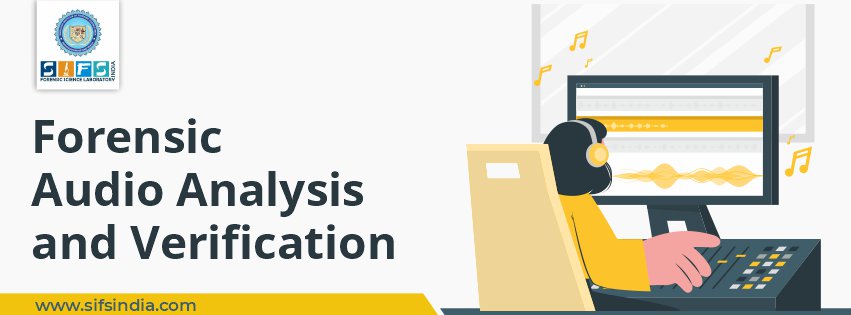Audio Forensics is a branch of forensic science. In general, forensic science refers to the examination of evidence that can be presented in the court or as part of a formal investigation.
As a result, forensic audio analysis refers to the collection, study, and interpretation of audio recordings as part of an official prosecution, such as preparation for a civil or criminal proceeding, or as part of the investigation of an incident or other occurrence containing audio evidence.
Voice authentication, transcription of linguistic content or disputed utterance examination, speech enhancement, and the analysis of non speech events are the key fields of forensic audio analysis.
One of the most basic criteria is that the recording should be authenticated.
Role of Audio Forensic Examiner
The audio forensic examiner attempts to confirm that the recording was made under controlled conditions, held in a recorded chain of custody, and the recording was not changed intentionally prior to testing.
Filters may be used to enhance the clarity of an audio file, which includes removing unnecessary noise or improving speech intelligibility.
Recordings are often taken in less-than-ideal conditions, such as when someone is wearing a body wire. Using audio processing tools, you can be able to detect faint voices or occurrences more easily on playback.
Audio transcription is aided by a comprehensive text editor that includes: highlighting of speaker utterances, easy speech segmentation, text-to-audio binding and quick text navigation, and automated search of matching terms and phrases for further comparative study.
Identifying individuals or objects from a video image or voice on an audio recording necessitates Image Content Analysis or Speech Science Instruction. In order to make a positive identification, these examinations compare an unknown recording to a known recording or an unknown entity to a known object in great detail. Speech Interpretation and comparison is a developing field of study that can be contentious in criminal cases.
The examiner closely listens to the entire recording and makes note of any obvious changes or anomalies.
Static noises, tones, buzzes, and other noticeable discontinuities are noted, whether there is any audible evidence of splices, edits, or audible discontinuities.
Due to the widespread availability of portable devices (such as smartphones and tablets) equipped with a video camera and the availability of multimedia data editing software, acquiring, editing, storing, and transmitting an image or video are now extremely simple tasks.
These facts have highlighted the need for efficient forensic analysis algorithms that can detect alterations and verify the authenticity of a given piece of content.
Forensic Audio Analysis Techniques
Forensic audio techniques have long been researched. The vast majority of these solutions seek to improve sections of audio signals, locate sound sources, and distinguish scenes or places from audio tracks that sound heavily distorted by noise.
Frequency equalization may be used to improve or cut particular frequency bands using highly precise equalizers.
The frequency band containing most speech material, 200Hz–5000Hz, can be amplified or separated to help make speech more intelligible.
When a frequency spectrum is amplified, all other information within that frequency range is amplified as well.
Spectral subtraction is a digital signal processing procedure that involves determining a short-term noise distribution approximation and subtracting it from the spectrum of short frames of a noisy input signal.
Following the subtraction, the spectrum is used to reproduce the output signal's noise-reduced frame, and the procedure is repeated with successive frames to generate the entire output signal. An overlap-add technique is used to generate a signal.
At this moment, courts of law depend solely on human experts to transcribe dialogue and documents, along with determining the probability that a certain individual's voice is present in a forensic audio file.
A common scenario is where a police officer suspects that a suspected perpetrator said the words in a recorded phone call, but the defendant insists that it is his voice on the tape.
The forensic examiner may provide an opinion based on an analysis of the aural-spectrographic data, but the reliability and impartial criteria of such a subjective test can be questioned.
As a result, novel methods that can be demonstrated using proven accuracy and reliability figures will be particularly useful in supplementing human listeners, transcribers, and subjective aural-spectrographic methodology.
Conclusion
Audio forensics necessitates experience in a wide range of audio, acoustics, and signal processing areas.
The increasing availability of low-cost digital recorders and other ways of collecting speech and audio data suggests that there will be potential opportunities.
There is a high market for audio forensic techniques and facilities. The use of data handling techniques that satisfy the criteria for admissibility of legal cases will continue to be an important aspect of audio forensic investigations.
References
Maher, R. C. (2018). Introduction to Forensic Audio Analysis: Authenticity, Enhancement, and Interpretation. Principles of Forensic Audio Analysis, 1–2.
Maher R.C. (2010) Overview of Audio Forensics. In: Sencar H.T., Velastin S., Nikolaidis N., Lian S. (eds) Intelligent Multimedia Analysis for Security Applications. Studies in Computational Intelligence, vol 282. Springer, Berlin, Heidelberg. //doi.org/10.1007/978-3-642-11756-5_6.
Maher, R. C. (2009). Audio forensic examination: Authenticity, enhancement, and interpretation. IEEE Signal Processing Magazine, 26, 84–94.
NFSTC. “A Simplified Guide to Crime Scene Investigation” //www.forensicsciencesimplified.org/av/how.html, National Forensic Science Technology Center, September 2013.

 August 09, 2021 - BY SIFS India
August 09, 2021 - BY SIFS India